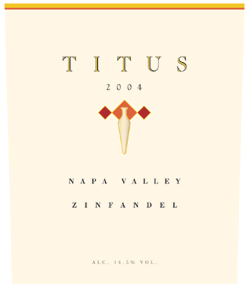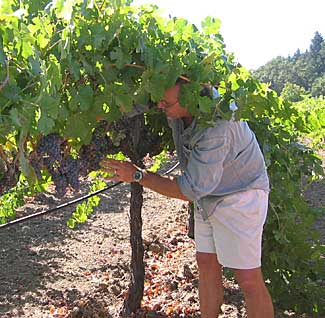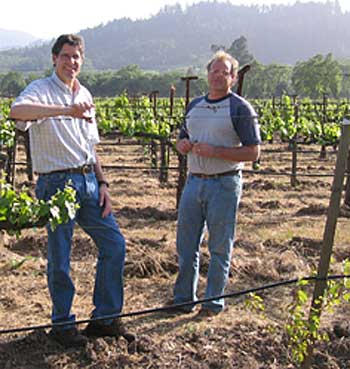

Titus Vineyards is smack dab in the epicenter of Napa Valley and each of their wines manifest the essence of the terroir from which they come.
St. Helena ~ Napa Valley (AVA)
The Titus Touch at the
Choke Point of the Napa Valley
Because we’re in the choke point with steep valley walls, the heat sits in here. We’re probably one of the warmest spots in the valley. I like to think of us as one who represents the epitome of St. Helena because of the heat and our proximity to the river.
~Eric Titus
by
Alan Goldfarb
March 30, 2007
Eric Titus (ET): If I ever knew, I’ve forgotten. (But) we’re very close to the Napa River and we’re near Lodi Lane, which is the choke point of the valley.
In the New Year’s flood of 2005, we were totally under water. This illustrated to me how this soil got to be what it is. There was a lot of sand. We have fairly lean soil out by the river that is gravelly and sandy and there’s a lot of obsidian (black volcanic stone, deposited from nearby Glass Mountain). (At the river, which

Eric Titus lovingly checks out his Cabernet Franc grapes right before harvest.
Our location here is very representative of the St. Helena appellation. Because we’re in the choke point with steep valley walls, the heat sits in here. We’re probably one of the warmest spots in the valley. I like to think of us as one who represents the epitome of St. Helena because of the heat and our proximity to the river.
We don’t have many insects, so we’re able to farm with low impact; the lower (use of chemicals) the better. We’re not certified organic but we sure as Hell could be.
AG: Because of those growing conditions, it seems as though it’s the perfect spot for Zinfandel and Petite Sirah.
Eric Titus: We’ve maintained the heritage varietals – Petit Sirah and Zinfandel. Zinfandel is truly our heritage before the Bordeaux varietals became (popular). Our Zin (planted in 1977 and ’78 next to the Silverado Trail, some of which has been going to Charles Krug since the 1940s) is established and we don’t see any need for irrigation. They don’t show stress. They’re deep (rooted) and the quality doesn’t seem to be suffering.
AG: Describe then, your Zinfandel.
ET: It’s up-valley Zin. From St. Helena, they are medium-bodied and not super-extracted. It’s more spice-driven with less

Phillip (left) and Eric Titus inspect a block of their winery’s vineyards.
AG: It’s been said that by not blending vineyards and by not irrigating, the grapes have the best chance to show their terroir. Do you think so?
ET: It’s kind of a neat philosophy to buy into (dry-farming). (But) it comes down to the root-hair interface. That’s where terroir is determined.
AG: Root-hair interface? Is that some kind of computer term?
ET: It’s the difference between going to a chiropractor and an orthopedic surgeon: It probably doesn’t hold a lot of weight, but the idea is a good one. Zinfandel is probably the best at determining that what’s in the vineyard is in the bottle. With Zinfandel, you get those flavor notes (from the vineyard). (So) root-hair interfacing is where the plant is taking its nutrients and the soil type will determine the nutrients. … That’s an expression of how the plant is working and also how hard it is working.
AG: So, are the root hairs the tendrils of the plant? And the interface is where the root hairs interact with the soil?
ET: It’s the point of contact between the plant and its environment, the soils. Root hair is where the root gets more contact. That’s where the water and nutrients come through.
AG: The wines are being made at Chappellet Winery (on Pritchard Hill in the eastern hills above the Trail) by your brother (who’s been the winemaker there for the last 18 years). Have you thought of a winery for Titus?
ET: Things work very pretty well now with Chappellet but we might soon run out of space. (Titus’ production of Cabernet, Zin, Petit Sirah and soon Sauv Blanc is at about 6,500 cases. But beginning with the last vintage that number will jump to 9,500.) So, it’s the right time now, within the next few months to research what we can do on this property (in terms of building a winery). But it’s in a flood plane and it’s quite congested here (with tourist and winery traffic).
I have had my head in the sand (no pun intended), but now I have to look at it. If we had a building, we could go up to 12,000 cases and without a doubt, it would raise our profile.
AG: Do you desire that?
ET: Yes, but sometimes it’s easier to stick with what you’re familiar with. We have a good product, people recognize that and our price point (which starts at $25 for the Zinfandel and rises to $60 for the Cabernet reserve), is lower than most Napa Valley producers. It’s not necessary to raise our profile but we want people to know we have a stake here. (Note: Titus’ parents bought the property in 1967).










 READER FEEDBACK: To post your comments on this story,
READER FEEDBACK: To post your comments on this story,




